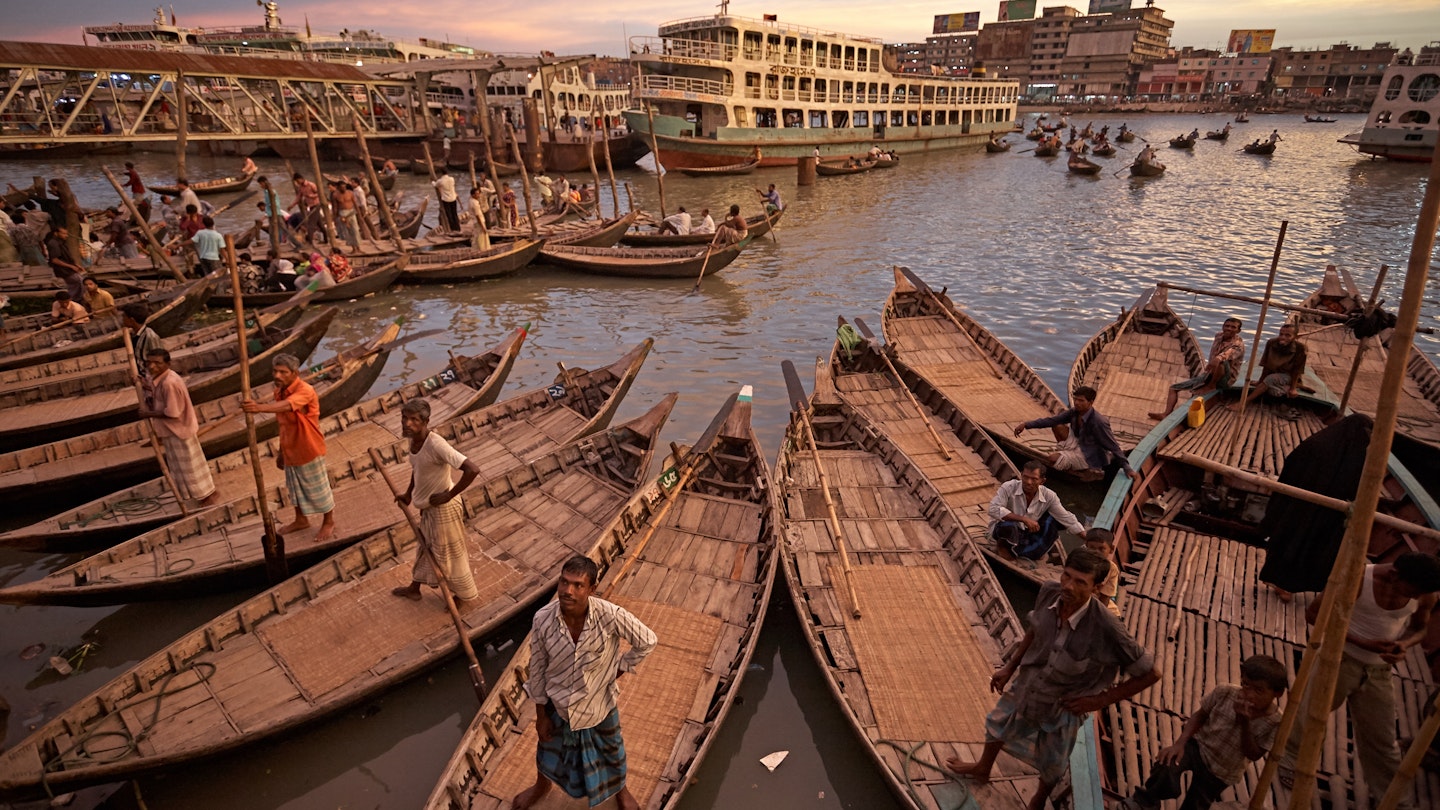Few would consider Bangladesh an expensive country to visit, but an unbeatable aspect of exploring Dhaka is that many of its top sights and activities still remain absolutely free to enjoy. From people watching at the ferry terminal to visiting the city’s most beautiful mosques, here’s our pick of the best free things to do in the Bangladesh capital.
1. People-watch from the jetties of Sadarghat
One of the most atmospheric places in Dhaka is the main ferry terminal of Sadarghat, a series of jetties stretched out along the banks of the Buriganga River. A fabulous location for people-watching, Sadarghat comes alive in the early mornings, when hulking launch boats connecting Dhaka to other towns in the southern deltaic regions moor at the docks, disgorging thousands of commuters from their wood-and-metal innards. In the late evenings, throngs of passengers board the same vessels departing on overnight cruises to their respective destinations.
Technically, you need to buy a ‘platform ticket’ to gain access to the piers for a meagre Tk 5 (6 US cents), but the return on your expense is disproportionately tilted in your favour.
2. Seek blessings at Dhakeswari Temple
The nerve centre of the Hindu faith in Bangladesh, Dhakeswari Temple is believed to have been founded nine centuries ago. Popular opinion converges on the assumption that the city got its name from the temple’s resident deity, Dhakeswari, an incarnation of the Hindu mother goddess.
The temple welcomes people from all faiths; you can visit the main shrine to seek the deity’s blessings and light incense sticks or candles in a sand bunk across the main courtyard as a symbolic offering. Every year in September and October, the temple comes alive in a riot of festivities during the four-day-long Durga Puja festival, celebrated with much ritual and public fanfare.
3. Stroll the grounds of Dhaka University
Given Dhaka’s otherwise unkempt urban profile, the leafy and pretty premises of Dhaka University are a delight to explore on foot. Established in 1921, while Bangladesh was part of undivided India under British rule, the university is considered Dhaka’s premier educational institution. It continues to draw scholars, teachers, and academic visitors from around the world.
The central attraction of the university is the brick-red Curzon Hall, a quasi-Gothic building constructed in 1905, exemplifying the European-Mughal architectural style admired by British administration at the time. While strolling, you will also notice several significant buildings and halls, as well as sites of historic importance related to the Liberation War in 1971.
4. Visit Dhaka’s standout mosques
Do not miss the opportunity to visit Dhaka’s mosques—they are simply stunning. The grandest among them is the modern Baitul Mukarram Mosque, designed in the manner of the Ka’aba at Mecca. In contrast, the ancient onion-domed Sat Gumbad Mosque, dating back to 1680, remains a remarkable example of Mughal-style architecture. Additionally, Khan Mohammed Mridha’s Mosque, built in 1706, features a trio of domes with minarets in each corner.
Furthermore, the unique Star Mosque, constructed in the early 18th century in the Mughal style, has been refurbished with Japanese and English porcelain tiles complementing its original mosaic work. In the stylish diplomatic enclave of Gulshan, the Gulshan Central Mosque showcases the futuristic ethos of 1960s architectural trends, evident in its rocket-shaped towers and geometric prayer hall.
5. See the artisans of Sankharia Bazar at work
Done up in bright colours and perpetually imbued with the aroma of burning incense, the bustling yet quaint riverside borough of Sankharia Bazar is one of Dhaka’s most photogenic neighborhoods. Most residents in the area, predominantly Hindu families who settled here over 300 years ago, are craftsmen, making their living by carving decorative pieces, religious paraphernalia, and jewellery, such as bangles and necklaces, from conch shells.
While endangered in the modern world of assembly-line production, many believe this niche handicraft is poised for extinction. However, the passion and artistic finery of each artisan’s daily work remain evident. You are welcome to visit the studios and observe a conch carver at work. Observing is free; alternatively, consider buying a reasonably priced item as a souvenir in appreciation of the maker’s efforts.
6. Chill out in the city’s public gardens
One of Dhaka’s most expansive green areas, the tree-lined Ramna Park was initially designated by Mughal rulers as a recreational area. It remains largely used as a public relaxation space, enhanced by the presence of a lake within the park, which increases its ecological appeal alongside the abundant greenery surrounding it.
Adjacent to Ramna Park, the expansive Suhrawardi Park was originally a racecourse designed by the British. It later assumed immense historical importance as the venue where the Bangladeshi Declaration of Independence was announced and the surrender of Pakistani forces occurred after the end of the Liberation War in 1971. Both parks are open throughout the day, and Suhrawardi Park transitions into an open-air market during the evenings.




